There are certain requirements and interpretive frameworks that apply U.S. design patent applications that may not be intuitive. Many of these U.S. standards also differ significantly from the rules the apply to industrial design registrations in other countries. What follows is a guide to some common mistakes and misunderstandings around design patents and applications.
Additional information about acceptable practices for design patent applications can be found in the U.S. Patent & Trademark Office’s (USPTO’s) design patent application guide and in the Manual of Patent Examining Procedure (MPEP) Chapter 1500.
“Engineering” Style Drawings Treated Unfavorably
Designers may create computer-aided drafting (CAD) drawings to document their designs. These often follow engineering conventions, including the use of “tangent” lines to show the boundaries of a curved surface. However, U.S. design patent practice relies on the use of surface shading lines or stippling . This is any entirely different style and approach than familiar engineering standards. But there is no single explicit rule or statute about the permitted format of shading lines in design patent drawings.
Shading lines or stippling that contrast with the rest of a drawing are used to show curves, tapers, and other three-dimensional (3D) contours in design patent drawings. The arrangement and variable spacing of straight shading lines is commonly used to indicate the character of curvature or contouring. Shading lines that are not straight may also be permissible. Surface shading lines can be broken/discontinuous and/or light/thin to differentiate them from lines indicating surface ornamentation and/or the ornamental shape of an article itself. Although they must be used sparingly, with as few in number as practicable.
Other characteristics can also be represented by shading lines. For instance, equally spaced shading lines arranged parallel to each other are used to indicate flat surfaces. Shading lines or stippling can be used to distinguish open areas (like holes) from solid material as well. Also, oblique line shading is used to show transparent, translucent, and highly polished or reflective surfaces, such as a mirror. Elements visible behind transparent/translucent surfaces should be shown in light, full lines rather than in broken lines.
The following is an example used in the USPTO’s design patent application guide to illustrate straight, parallel shading lines with their spacing using to show curved edges of a sink. These shading or contour lines are discontinuous, each having a long unbroken segment plus a short, dot-like segment slightly spaced from an end of the long segment. In this example, other discontinuous shading lines are used to illustrate flat surfaces too.
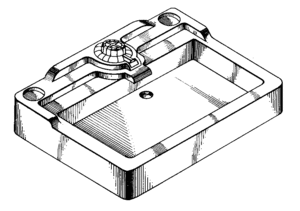
The following example is also from the USPTO’s design patent application guide, and shows a wheel hub with a combination of shading lines and stippling. The shading lines indicate contouring/curvature and well as flat surfaces. Some of those shading lines are discontinuous while others are continuous but light lines. Contrast in materials or surface texture may be shown by using line shading in one area and stippling in another. In this example, the stippling can show matte surfaces in contrast with highly polished surfaces shown in line shading.
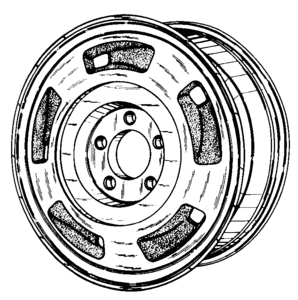
The following is an example of non-linear (curved) shading lines used to illustrate 3D curvature of a vehicle mirror. These shading or contour lines are discontinuous to distinguish them. These types of shading lines are appropriate for illustrating more complex 3D shapes. In this example, broken (dashed) line(s) further illustrate the boundary of the claimed design, meaning that only a portion of the depicted article is part of this claimed design.
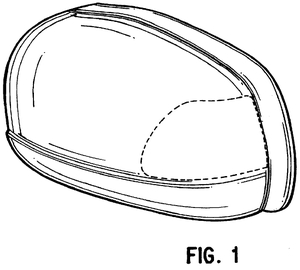
The following examples are drawn from a case about alleged infringement of two design patents covering a trash can and a recycling bin. Red arrows indicate lines whose meaning was disputed by the parties. The court construed the patents’ engineering-style drawings with curvature boundary tangent lines to mean visible ornamentation in the form of seams, paint, or something else that appears as actual lines on the trash can or recycling bin rather than merely conveying the boundaries of 3D contours where they transition to flat surfaces.
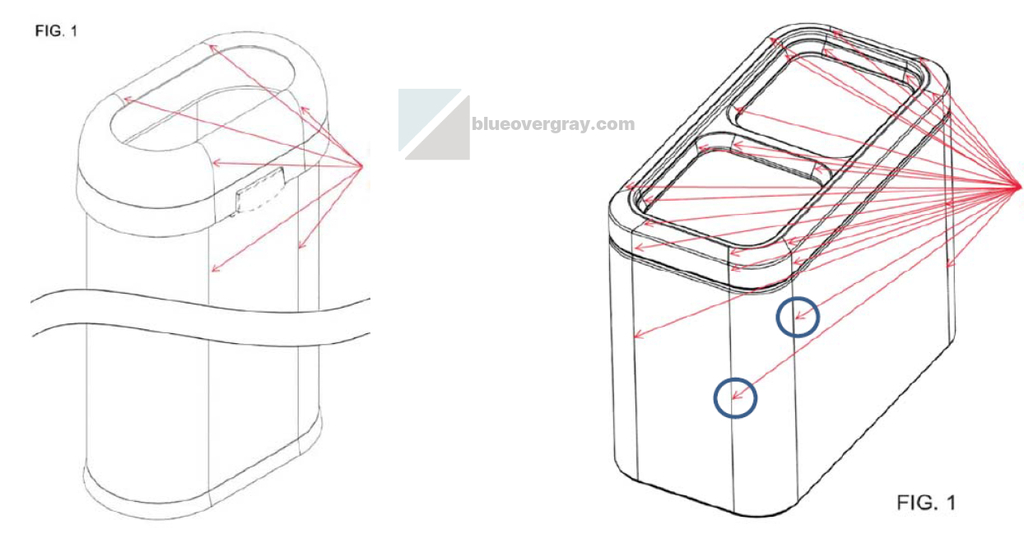
The court reasoned that because the purported drafting technique in the examples above made it impossible to distinguish contour changes from ornamental lines, and because such ambiguous usage raises indefiniteness concerns that should be discouraged, a “plain meaning” interpretation was adopted, finding that the disputed lines are lines (that is, ornamental features in the form of seams, paint, or something else that appear as actual lines on the articles). The patentee’s arguments that the disputed lines were shading or contour lines merely meant to demonstrate the general shape of the trash can/recycling bin were rejected.
The case later settled, and was dismissed without a final ruling on infringement. But the patentee would undoubtedly have lost under the court’s construction that the disputed engineering-style lines meant visible ornamental lines — neither the patentee’s own products nor the accused products had any features that resembled visible lines in the relevant locations.
The Title is Limiting
U.S. design patents are directed to ornamental features of useful articles. Significantly, they cover only particular articles that embody the claimed design, and not simply a “view” or “look” in the abstract (as is the case for industrial designs in some other jurisdictions). The words of the claim — which always says “as shown and described” — will limit the scope of the exclusive patent legal rights. Courts have said that the title of a design patent is limiting, where it names a particular type of article. And that is the case even if the drawings of a design patent do not illustrate any particular article. So the title and other words in a design patent application should be chosen carefully.
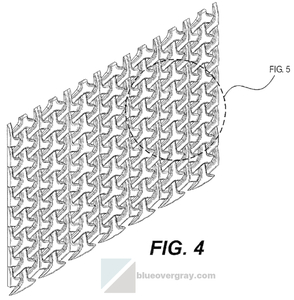
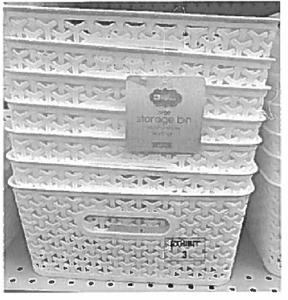
In the example reproduced above, a figure from a design patent shows a “Y”-shaped, rattan wickerwork-style pattern formed by a web of material. None of the figures in the patent illustrated the design being applied to a particular article, only the pattern formed by a portion of material shown in isolation. But the title of the patent is “Pattern for a Chair”. A court ruled that the patent’s claim was limited to a pattern for a chair, as specified in the title, and a lawsuit against a seller of a basket (not a chair) with a similar pattern making up the basket/bin walls was dismissed for failure to state a plausible claim of design patent infringement.


Limits on claim scope by the title or other text might help distinguish prior art. In the example images above, a design patent claim for the “ornamental design for a lip implant” was limited to lip implants. A court said that a prior art tool made of tightly spiral-wound paper called a “stump”, used by artists for smoothing and blending large areas of pastel, charcoal, or pencil, was directed to a different article than the claimed lip implant. Therefore, the prior art “stump” did not affect the novelty of the claimed design even though their shapes were essentially the same. However, an older case held that if the prior art discloses any article of substantially the same appearance it is immaterial what its use was, so this lip implant decision is in tension with that precedent.
The title of a design application can also potentially limit the prior art available as “comparison” art in a later three-way comparison of the claimed design, an accused product, and the closest prior art for an infringement analysis. Such a comparison can highlight differences (or similarities) in the overall appearance that might not otherwise be apparent to an ordinary observer. To qualify as comparison prior art, a notable court decision said that the prior-art design must be applied to the article of manufacture identified in the claim of the asserted design patent.
Partial Claims Are Permitted
It is possible to depict an article while using a partial claim that addresses the design of only a portion of that article. Structure that is not part of the claimed design, but is considered necessary to show the environment in which the design is associated, may be represented in the drawing by broken lines. This includes any portion of an article in which the design is embodied, or applied to, that is not considered part of the claimed design. For instance, when the design is for surface ornamentation, the shape of article to which the design is applied can be shown in broken lines.
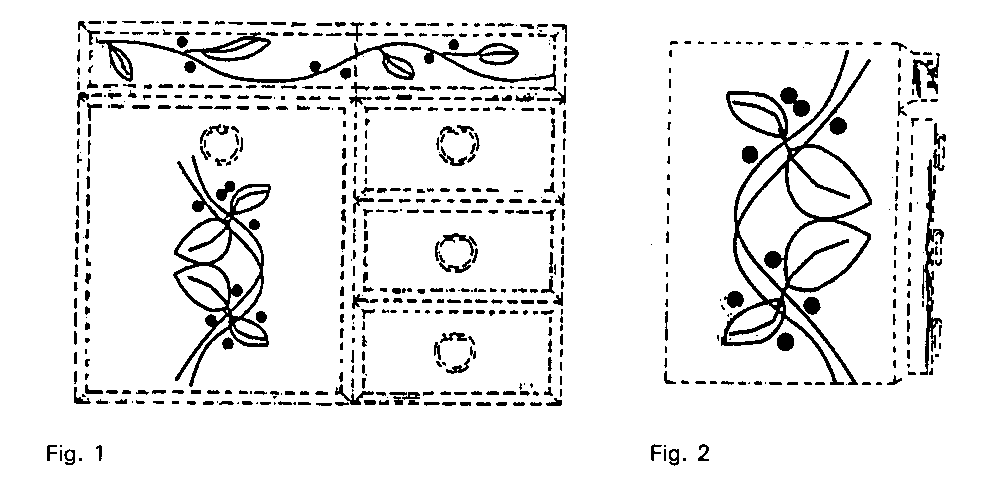
Moreover, unclaimed things may be shown in broken lines for the purpose of illustrating the environment in which the article embodying the design is used. For instance, a claimed design might be for the hood of a truck, only, with the rest of the truck shown in broken lines as unclaimed environment.
Unclaimed subject matter must be described as forming no part of the claimed design or of a specified embodiment thereof. A boundary line may be shown in broken lines if it is not intended to form part of the claimed design. Applicant may choose to define the bounds of a claimed design with broken lines when the boundary does not exist in reality in the article embodying the design. It would be understood that the claimed design extends to the boundary but does not include the boundary.Unclaimed subject matter must be described as forming no part of the claimed design or of a specified embodiment thereof. In this situation, broken (dashed) lines are used to define the boundary of a design patent application claim. This practice in the U.S. departs from that of some other countries where partial claims are not permitted.
Additionally, structure that is not part of the claimed design, but is considered necessary to show the environment in which the design is associated, may be represented in the drawing by broken lines. This includes any portion of an article in which the design is embodied, or applied to, that is not considered part of the claimed design.
USPTO Will Often Not Permit Changes in Claim Scope by Amendment
One controversial aspect of U.S. design practice is that changes in claim scope are usually not permitted. While partial claims are permitted in design applications, and while claim amendments in utility patent applications are routinely permitted (even to remove limitations), since 2013 the USPTO does not ordinarily permit lines to be changed from solid to broken (dashed) to broaden the claim, or the reverse to narrow the claim. Instead, applicants are often forced to file a separate application with a different claim scope. While examiners have some discretion to permit drawing changes, such as to fix discrepancies by changing lines to broken ones, and the text of disclaimers or statements in an appendix might have some impact, those things are not certain to be effective under current law and practice.
This practice of precluding changes in design application claim scope extends an already controversial position taken by a U.S. appeals court that reads a so-called “written description” possession requirement into the U.S. patent statutes (relating to enablement) against their plain language and grammar. Note that there is also a clear incentive for the USPTO to require new filings instead of amendments in order to generate more filing fees.
Multiple Embodiments are Sometimes Permitted
It is possible to include multiple embodiments in a single U.S. design application. However, restriction practice still applies and may require dividing different embodiments/designs into separate applications. Because design applications can have only a single claim, multiple embodiments must be patentably indistinct to remain in a single case.
On the one hand, because design patents have a 15-year term from grant, later-filed and later-granted divisional applications will expire later. This might be desirable for some patentees. On the other hand, a restriction determination also has an impact on the scope of exclusive rights. For instance, if the applicant elects one embodiment but declines to pursue an unelected embodiment in a divisional application, the unelected/abandoned embodiment will effectively be surrendered and dedicated to the public. These considerations emphasize the need to think through the implications and potentially commit to filing multiple applications when multiple distinct design embodiments are involved.
Drawings Must be Definite and Enabling
Drawings in a design patent application must be consistent with each other. Discrepancies between different views can create indefiniteness and/or lack of enablement issues. For instance, if certain features are shown in one view but omitted in another, this may make it unclear what design is really being claimed. The use of inconsistent drafting techniques in different drawings can also lead to similar concerns. For instance, discrepancies in the use of shading lines, stippling, and/or broken lines can detract from required clarity. Particularly for highly complex illustrations, it is important to carefully review the drawings to ensure that they are consistent.
A frequent issue is when there are holes, cavities, protrusions, or the like and their depth or height is potentially uncertain in plan or elevation views. Sometimes examiners may require cross-sectional views to show the depth of such features. But clarifying sectional views cannot always be added after initial filing without impermissibly adding new matter–instead a new continuation-in-part application might be necessary.
Mixing Photographs and Line Drawings is Not Permitted
Black and white line drawings are preferred and ordinarily required in U.S. design applications. However, photographs can sometimes be used, particularly where there is surface ornamentation that is not reproducible in line drawings. Such photographs can have added lines, such as broken lines to indicate a boundary of the claimed design. But it is not permitted to have both photographs and line drawings combined in a single design patent.
It is possible to include a mix of photographs and line drawings in a new U.S. design application, which might have significance for priority claims or divisional filings, but the drawings must be amended and limited to one or the other type before grant. If photographs are included as informal drawings in a new application, then a disclaimer included in the specification or on the photographs themselves should be used to disclaim any color, surface ornamentation, logos, written matter, etc. that forms no part of the claimed design.
Color Can Be Claimed
Use of color presents many opportunities for procedural problems and well as unintended impacts on the scope of claimed design patent rights. Color can be claimed in a design patent application. However, the use of color drawings (including color photographs) requires filing a petition and paying a petition fee to have color drawings accepted. Also, there is a requirement that the specification include the following statement:
“The patent or application file contains at least one drawing executed in color. Copies of this patent or patent application publication with color drawing(s) will be provided by the Office upon request and payment of the necessary fee.”
Instead of using color drawings, an alternative is to use black & white line drawings lined for color in accordance with the drawing symbols in MPEP § 608.02 (and reproduced in the USPTO’s design patent application guide). Essentially there are particular line patterns usable to represent specific colors. If this is done, the application must state “The drawing is lined for color.” The specific colors lined in the drawing(s) may also be identified in the specification for clarity, as a kind of legend that explains the lining patterns from MPEP § 608.02.
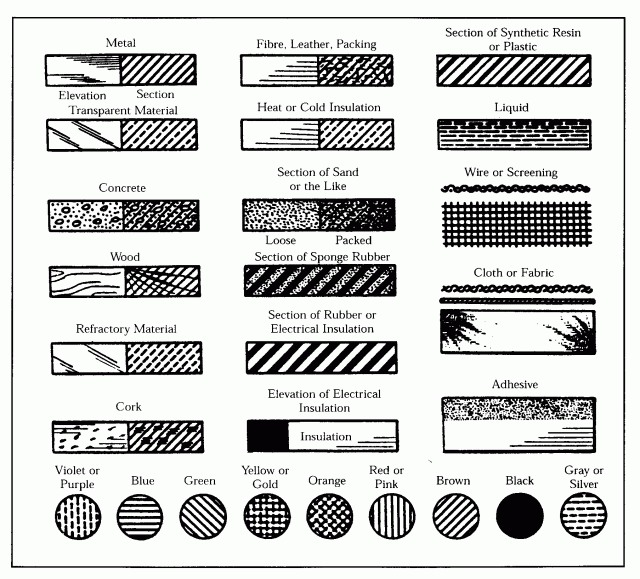
Also, if color photographs are initially submitted as informal drawings (to later be replaced with formal drawings) and the applicant does not consider the color to be part of the claimed design, a disclaimer should be added to the specification as follows: “The color shown on the claimed design forms no part thereof.” The USPTO will consider color an integral part of the disclosed and claimed design in the absence of a disclaimer filed with the original application.
Appendices Are Permitted
Although not specifically discussed in MPEP Chapter 1550, the USPTO’s design patent application guide, or reported court cases, the USPTO currently permits design applications to include an appendix. The appendix is never published in granted design patents. An appendix can include text statements, such as a purported reservation of the right to change solid lines to broken lines or vice-versa, additional views or embodiments, which could be in the form of line drawings, photographs, or both. The main purpose of an appendix is to potentially provide support for a greater range of amendments and/or continuing applications after initial filing.
Applicants will sometimes not include an appendix because they are unaware that it is possible to do so. After all, the USPTO does not expressly discuss them in any of its regulations or procedural guidelines. Courts have not definitively ruled on the permissible use of design application appendices, however. Yet design examiners generally allow applicants to include and rely on them and generally do not object to their use.
Functional Aspects Are Not Protected
Sometimes design patent applicants wrongly believe that a design patent will cover functional aspects or a general idea. They do not. The type of subject matter that can be claimed in design patents is different from utility patents.
Design patent protection is limited to protection of ornamental aspects of a useful article. Purely functional aspects or a broader general design concept are not protected. Also, anything dictated by function, no matter how aesthetically pleasing, cannot be protected by a design patent. Where this becomes less clear is where design features are only partly functional, and they contribute at least some minimal ornamentation to the overall design. In those situations, the functional aspects limit the scope of protection in the overall design without completely precluding protection of the minimally ornamental aspects.

Austen Zuege is an attorney at law and registered U.S. patent attorney in Minneapolis whose practice encompasses patents, trademarks, copyrights, domain name cybersquatting, IP agreements and licensing, freedom-to-operate studies, client counseling, and IP litigation. If you have patent, trademark, or other IP issues, he can help.
